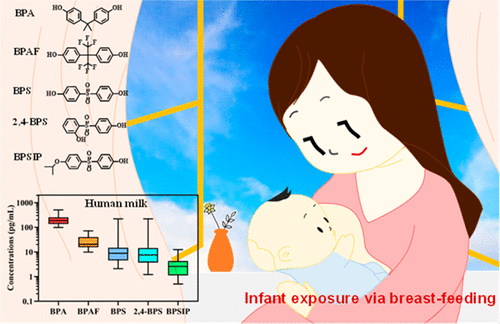当前位置:
X-MOL 学术
›
Environ. Sci. Technol. Lett.
›
论文详情
Our official English website, www.x-mol.net, welcomes your
feedback! (Note: you will need to create a separate account there.)
Occurrence of Multiple Bisphenol S Derivatives in Breast Milk from Chinese Lactating Women and Implications for Exposure in Breast-fed Infants
Environmental Science & Technology Letters ( IF 8.9 ) Pub Date : 2020-12-10 , DOI: 10.1021/acs.estlett.0c00883 Dan Luo 1 , Yanan Pan 1 , Lixi Zeng 1 , Bibai Du 1 , Juan Li 1 , Surong Mei 2
Environmental Science & Technology Letters ( IF 8.9 ) Pub Date : 2020-12-10 , DOI: 10.1021/acs.estlett.0c00883 Dan Luo 1 , Yanan Pan 1 , Lixi Zeng 1 , Bibai Du 1 , Juan Li 1 , Surong Mei 2
Affiliation

|
Bisphenol S (BPS) derivatives have recently been reported as new bisphenol A (BPA) or BPS substitutes that occur in thermal paper worldwide. However, little is known about human exposure to these emerging chemicals. In this study, the occurrence of BPA, five commonly used BPA analogues, and a broad suite of 10 BPS derivatives was investigated in human breast milk samples from Chinese lactating women. In addition to BPA and five BPA analogues, seven of the ten target BPS derivatives were identified in the breast milk samples. Total concentrations of seven detectable BPS derivatives were in the range of 8.45–943 pg/mL, just slightly lower than those of five commonly used BPA analogues (34.5–1420 pg/mL). 2,4′-Bis(hydroxyphenyl)sulfone (2,4-BPS) and 4-hydroxyphenyl 4-isoprooxyphenylsulfone were the most frequently detected BPS derivatives, followed by 4-{[4-(allyloxy)phenyl]sulfonyl}phenol, 4-hydroxy-4′-benzyloxydiphenylsulfone, and bis(3-allyl-4-hydroxyphenyl)sulfone. Concentrations of 2,4-BPS were found to be similar to that of BPS in human breast milk. If BPS derivatives were included in a comprehensive exposure assessment, the estimated total daily intakes of BPA alternatives via breast-feeding would increase significantly for breast-fed infants but still correspond to low health risks. This is the first study to report multiple BPS derivatives in human breast milk.
更新日期:2021-02-09











































 京公网安备 11010802027423号
京公网安备 11010802027423号